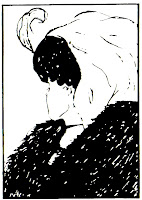A scientist, an orchid grower, and a perfumer walk into a bar. The bartender asks, “What would you like”? All three answer in unison, “One of everything!”

Of course, all three of those characters are me, in just a few of my different real-life roles. I’ve been repeatedly asked how I come to engage in so many seemingly incompatible activities, and I think the main answer, aside from failure to ever “grow up” and “settle down”, is probably an obsessive desire to collect and a really passionate sense of curiosity about everything under the sun. It’s not just about collecting objects, it’s about collecting experiences, which, I suppose, is a corollary of curiosity - the kind that killed the cat, took Peter Pan on his fabulous journeys, and produced the drifter and the dilettante. Scientists are curious about how things work. Orchid enthusiasts are curious about how plants grow, how they evolved, and how the offspring of different crosses will turn out. Perfumers are curious about what will happen if you mix certain things together, or curious about what to combine to make a novel scent that conveys a message. All of these undertakings are more fun if you have a big selection of toys to play with.

As a scientist, the modern incarnation of an alchemist, I collect methods and data, the more the better. The best way to answer any scientific question is to obtain data using as many different approaches as possible and see what elements they all have in common, where they diverge, and why. Come to think of it, this principle applies to any sort of learning or truth-seeking enterprise. It's interesting that every one of the old paintings depicting alchemists shows them in a messy, cluttered environment, the result of collecting. This looks just about right.

After I moved to Seattle about 15 years ago, I started seriously collecting orchids. When orchid plants became readily available to order online, I became obsessed with obtaining every species of orchid that I could lay my hands on, just because of my wonder at the amazing diversity of forms and lifestyles that have evolved within this one plant group. The collecting obsession eventually evolved into my own nursery business, Olympic Orchids. One of the things that I noticed was that the flowers of every orchid species have their own highly distinctive fragrance and I would always think to myself, “This would make a great perfume!”
At the same time I was collecting orchids, a huge variety of perfume samples and decants had become increasingly available online, so I engaged in a perfume sampling frenzy that is still ongoing. I was an avid essential oil collector and perfumista long before I was a perfumer. I continue to learn something from every perfume that I smell, regardless of whether it’s well or poorly made, and regardless of whether I like it or not. I’m not sure when and how it happened, but one day I tried mixing up some of my essential oils to see if I could re-create the scent of a particularly fragrant orchid. It didn’t really work, but the experiment did lead to a lot of learning, buying of new materials, and experimentation.
To go back to my own ancient history, I’ve always been fascinated by perfumes and odors. Even as a child I went around smelling everything, including my mother’s perfumes. Once I had my own money, I started collecting small bottles of essential oils, buying every oil that I could obtain. I didn’t really do anything with them, just sniffed them. At the time, it just seemed like a strange and perverse form of recreation, but now I realize that it was a form of education, getting to know perfume materials, satisfying my curiosity about how they smelled, going back to them again and again to learn those smells. Once I started trying in earnest to make perfumes, I branched out into aroma chemicals, which meant I had to learn a new and completely unfamiliar repertoire of odors. It’s sort of comparable to a musician going from simply playing the piano to making complicated electronic music and then combining the two. I’m still working on learning about aroma chemicals, incorporating new materials into my creations, and figuring out how to make them all play nicely together, but that’s the sort of challenge that keeps me engaged in any sort of activity.

 A huge thank-you to everyone who has helped support and promote my adventures in perfume making. I suspect that Gail was instrumental in requesting the Fragrantica listing, and I really appreciate everything that she has done. I also appreciate all of you who have posted reviews and comments here and elsewhere, and engaged in other types of networking - Tarleisio, Ines, Diana, Dee, and so many others that I haven't mentioned. As Olympic Orchids Artisan Perfumes approaches its one-year anniversary, it’s gratifying to be able to look forward to great things in the year ahead.
A huge thank-you to everyone who has helped support and promote my adventures in perfume making. I suspect that Gail was instrumental in requesting the Fragrantica listing, and I really appreciate everything that she has done. I also appreciate all of you who have posted reviews and comments here and elsewhere, and engaged in other types of networking - Tarleisio, Ines, Diana, Dee, and so many others that I haven't mentioned. As Olympic Orchids Artisan Perfumes approaches its one-year anniversary, it’s gratifying to be able to look forward to great things in the year ahead. 



















